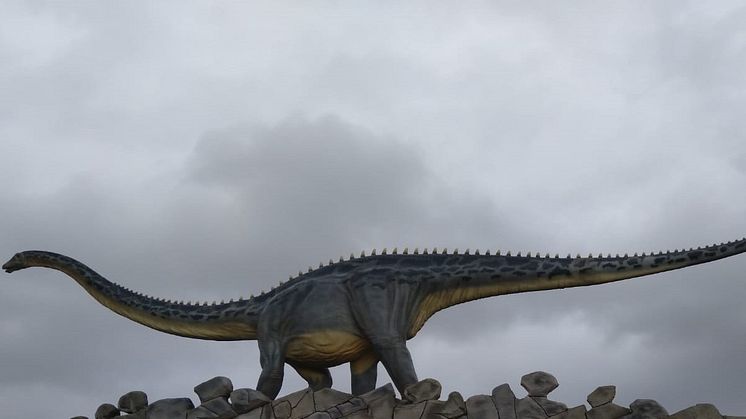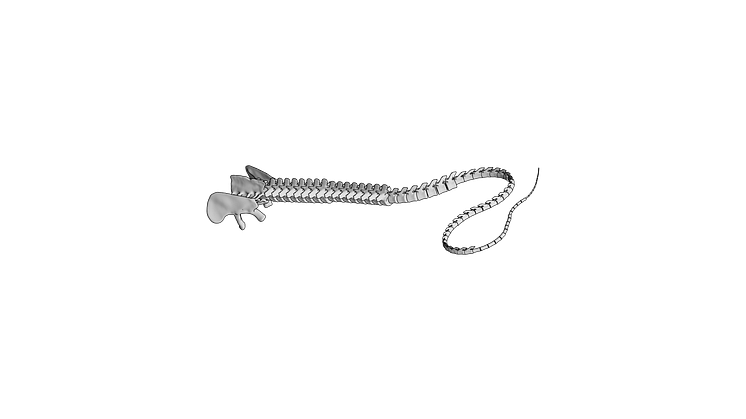
Press release -
Dinosaur tails didn't move at supersonic speeds
Through computer modelling, a study by the Politecnico di Milano demonstrated how the tails of long-necked dinosaurs, contrary to what previous studies claimed, could not reach supersonic speeds.
Diplodocids were a family of dinosaurs with long necks and, often, even longer tails, which in some species could reach 15 metres in length. They were widespread on Earth about 150 million years ago, known mainly from skeletons found in modern day North America. For decades, scholars have debated whether these dinosaurs could move their tails at supersonic speeds—that is, over 340 metres per second—creating a small ‘sonic boom’.
A new study, conducted by Simone Conti, PhD student at the Politecnico di Milano and at the Universidade NOVA de Lisboa and published in the journal Scientific Reports, adds a new element to the question of the speed reachable by the tail of dinosaurs. In fact, previous research claimed that Diplodocids were able to move their tails at supersonic speeds, in the theory that the noise produced would be useful as a deterrent to predators or as a means of communication. The new study instead maintains that the tails could not have exceeded a speed of 33 metres per second (about 100 kilometres per hour).
Conti, together with a research group made up of engineers and palaeontologists, simulated the movement of the tail, building a digital model based on five fossil specimens. The tail model is over 12 metres long, weighs 1446 kilograms and is made up of 82 cylindrical elements, corresponding to the vertebrae, all connected to a fixed base. This base serves to keep the tail still when set in motion in an arcing motion, which is similar to that of a whip. This movement allows the tip of the tail to accelerate up to 33 metres per second, which is ten times slower than the speed of sound and therefore too slow to generate a sonic boom.
The model of the Apatosaurus tail developed by Simone Conti
The authors also tested whether the tail design could withstand the stress created by moving fast enough to generate a sonic boom. The result of the new study shows that the tail would not have been able to withstand a speed of 340 metres per second, it would have already broken at speeds well below that of the sound barrier.
However, the authors do not exclude that diplodocids were able to move their tail fast enough to use it as a defensive weapon or for fighting with other similar ones.
The study was the result of the collaboration between the Department of Aerospace Sciences and Technologies of the Politecnico di Milano and the Department of Geology of the Universidade NOVA de Lisboa. A collaboration between such different research fields can be a precedent for many future projects, not only in geology and engineering, but also in other scientific disciplines
Related links
Topics
Categories
Politecnico di Milano is a scientific-technological university which trains engineers, architects and industrial designers.
The University has always focused on the quality and innovation of its teaching and research, developing a fruitful relationship with business and productive world by means of experimental research and technological transfer.
Research has always been linked to didactics and it is a priority commitment which has allowed Politecnico Milano to achieve high quality results at an international level as to join the university to the business world. Research constitutes a parallel path to that formed by cooperation and alliances with the industrial system.
Knowing the world in which you are going to work is a vital requirement for training students. By referring back to the needs of the industrial world and public administration, research is facilitated in following new paths and dealing with the need for constant and rapid innovation. The alliance with the industrial world, in many cases favored by Fondazione Politecnico and by consortiums to which Politecnico belong, allows the university to follow the vocation of the territories in which it operates and to be a stimulus for their development.
The challenge which is being met today projects this tradition which is strongly rooted in the territory beyond the borders of the country, in a relationship which is developing first of all at the European level with the objective of contributing to the creation of a single professional training market. Politecnico takes part in several research, sites and training projects collaborating with the most qualified European universities. Politecnico's contribution is increasingly being extended to other countries: from North America to Southeast Asia to Eastern Europe. Today the drive to internationalization sees Politecnico Milano taking part into the European and world network of leading technical universities and it offers several courses beside many which are entirely taught in English.


